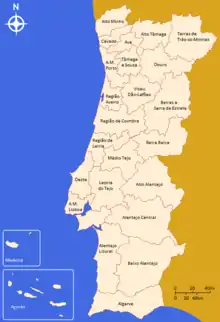Intermunicipal communities of Portugal
The intermunicipal community (Portuguese: comunidade intermunicipal) is a type of administrative division in Portugal. Since the 2013 local government reform, there are 21 intermunicipal communities.[1] They replaced the urban communities, the intermunicipal communities for general purposes and some metropolitan areas that were created in 2003,[2][3][4] and abolished in 2008.[5][2] The territories of the intermunicipal communities are the basis of the NUTS III statistical regions.

The branches of administration of the intermunicipal community are the intermunicipal assembly, the intermunicipal council, the intermunicipal executive secretariat and the strategic board for intermunicipal development. The intermunicipal assembly is composed of elected members of the municipal assemblies of the municipalities. The intermunicipal council is composed of the presidents of the municipal chambers of the municipalities.[1]
List
The intermunicipal communities are:[1]
References
- "Law nr. 75/2013" (pdf). Diário da República (in Portuguese). Assembly of the Republic (Portugal). Retrieved 13 August 2014.
- Fernanda Paula Oliveira (2009), The Evolution and Regulation of the Metropolitan Areas in Portugal at the Internet Archive PDF (677 kB)
- "Law nr. 10/2003" (pdf). Diário da República (in Portuguese). Assembly of the Republic (Portugal). Retrieved 13 August 2014.
- "Law nr. 11/2003" (pdf). Diário da República (in Portuguese). Assembly of the Republic (Portugal). Retrieved 13 August 2014.
- "Law nr. 45/2008" (pdf). Diário da República (in Portuguese). Assembly of the Republic (Portugal). Retrieved 13 August 2014.